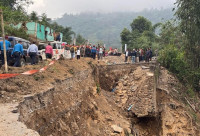Columns
Are we serious about our IT industry?
Digital (re)skilling is required to meet the expected labour demand for Nepal’s “billion dollar” IT industry.
Dipta Shah & Kshitiz Acharya
There are a few noteworthy things in the mainstream discourse about Nepal’s IT services industry. First, this industry has grown not because of, but in spite of, the Government of Nepal (GoN). Next, despite the social media hype, the industry is still in its infancy and nowhere near the mechanically cited “half-billion dollar industry”. Further, realising exponential growth in export-oriented IT services is the most immediate and achievable option to accelerate sustainable, equitable and inclusive job growth over the short-to-medium term.
There are several examples of IT services graduating into the mainstream. Also, there is evidence of constructive, forward-looking public sector support to create enabling environments along with sizable public sector investments. The Silicon Valley we know today grew from funding and research enabled by the US Defense Advanced Research Projects Agency (DARPA) starting in the 1950s. The IT sector in the Singaporean city-state grew out of recognising geographical limitations to traditional growth paths when that country was founded in the 1960s. India’s policy reforms that targeted the IT sector in the 1980s and 90s eventually gave rise to the juggernaut that is India’s IT services industry today.
Nepal’s experience is almost entirely entrepreneur-driven. The tech industry has innovated business models while regulators and policy-makers have struggled to keep pace. This is why the country’s digital ecosystem is replete with examples of reactive posturing by the government on everything—from retroactive VAT dues to taxation of capital gains on ownership transfers in off-shore jurisdictions.
A cynical view of such misguided attempts paints a picture of the bureaucracy that intends to punish success and stunt the growth of IT services industry. A more balanced take suggests a bureaucracy implementing anachronistic rules atop an industry with multi-jurisdictional business models, which is unfathomable. Adding to this confusion is the introduction of assumption-laden data points. This confusion compounds with endless regurgitating of sensational narratives on the potential of the IT services sector and the gap between reality and a make-believe world worth hundreds of millions of US dollars, if not billions.
From a valuation perspective, Nepal’s export-oriented comparative advantage is services (not products), so trading multiples for Nepal-based counterparts of foreign-domiciled companies are naturally subdued. From a revenue standpoint, Nepali companies have successfully deployed cost centres for their foreign-domiciled (parent) entities as the business model. This lays bare an obvious but glossed-over contradiction in forecasts about the potential of IT services in Nepal, i.e., the assumed availability of a skilled and growing IT labour pool into the indefinite future.
The labour conditions required to evolve from the current state to a future where Nepal as a destination for IT services is not assured. Migration data suggests the contrary: Nepali youths, the backbone of a desired services sector boom, are leaving Nepal in search of gainful employment in staggering numbers. Those leaving include the youngest and most qualified IT professionals the Nepali ecosystem can offer.
Highly celebrated outsourcing companies in Nepal are busy establishing operations in tier-2 and tier-3 cities in India and elsewhere. This dynamic is rising because wage rates naturally gravitate toward market-clearing levels regardless of physical location. In this eventuality, the rational approach for corporate decision-makers will be to grow their businesses in jurisdictions where the supply of IT labour is relatively abundant and the regulatory environments are predictable. Without deliberate action, Nepal is not well-positioned on either of these fronts.
These considerations lead to a simplistic outlook: For export-oriented IT services in Nepal to reach their potential, one must consider not just the theoretical possibility of global demand but also the practical limits of a faltering labour supply base. In addition, one must also account for upward pressures on prevailing IT services wage rates in Nepal, which seek equalisation with global benchmarks adjusted for factors like the relative cost of living. This dynamic entails margin compression for Nepali IT services businesses on the one hand and consequences for IT products and services for the domestic market on the other.
There is a substantial and unmet role for the government in helping enable the transition from academic forecasts to a reality of exponential growth in IT services. While attempts over the past five years to convert the Digital Nepal Framework (2019) into investments in public digital infrastructure and policy reforms have been less successful, efforts underway, including those under the chairmanship of the Prime Minister through Nepal’s eGovernance Commission, offer hope at a streamlined policy environment with positive knock-on impacts for Nepal’s IT outsourcing industry.
Further, there is room to do more in digital (re)skilling to meet the expected labour demand for Nepal’s “billion dollar” IT services industry. Even though this is a complex endeavour, it can benefit the entire digital ecosystem if thoughtfully implemented. The government’s participation in a PPP model, similar to that of India’s National Skill Development Corporation, could be an avenue to be explored.
Nepal has a small but fast-shrinking window of opportunity to reposition its economy as a global outsourcing powerhouse. Success on this front would be far more transformational and impactful than any other alternative over the short-to-medium term horizon.




 14.12°C Kathmandu
14.12°C Kathmandu
















